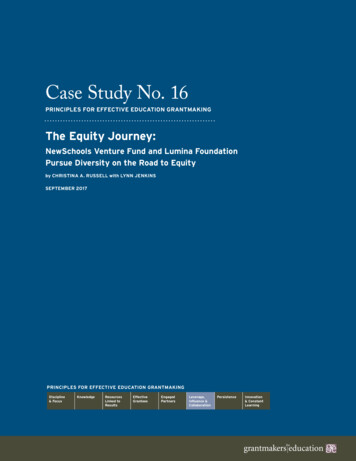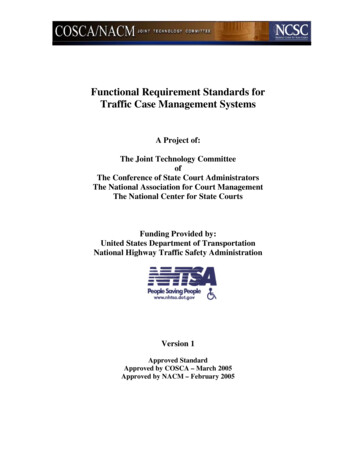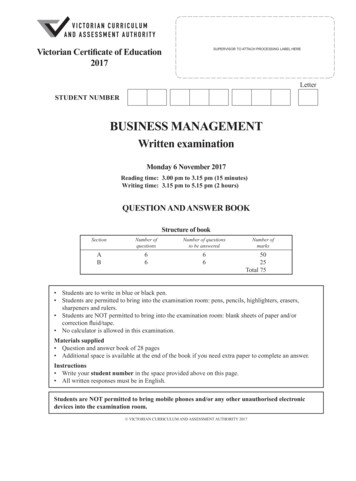
Transcription
Case Study No. 16Principles For Effective Education GrantmakingThe Equity Journey:NewSchools Venture Fund and Lumina FoundationPursue Diversity on the Road to Equityby Christina A. Russell with Lynn JenkinsSEPTEMBER 2017PRINCIPLES FOR EFFECTIVE EDUCATION GRANTMAKINGDiscipline& FocusKnowledgeResourcesLinked Influence &CollaborationPersistenceInnovation& ConstantLearning1
Grantmakers for Education exists to improve outcomes forall learners by serving as a trusted partner for all educationphilanthropists as they adapt to the changes impacting ourworld. To accomplish this, Grantmakers for Education’s purposeis two-fold:1. To provide members with an informal and balancedenvironment for collaborating, discussing and acting onimportant issues in public education.2. T o help members identify and prepare for what’s next. Withour finger on the pulse of our diverse network and eye onthe broader horizon, we keep members informed of relevantand pressing issues, and equip members with the tools andknowledge required to shape the future.Grantmakers for Education developed its series of case studies on effectiveeducation grantmaking as reflection and discussion tools. Cases are notintended to serve as endorsements, sources of primary data or illustrationsof successful or unsuccessful grantmaking. In addition, to help make the casea more effective learning tool, it is deliberately written from one foundation’spoint of view, even though other foundations may have been involved in similaractivities or supported the same grantees.Copyright Grantmakers for Education2
Case Study No. 16Principles For Effective Education GrantmakingThe Equity Journey:NewSchools Venture Fund and Lumina FoundationPursue Diversity on the Road to Equityby Christina A. Russell with Lynn JenkinsSEPTEMBER 20173
Table of ContentsINTRODUCTION5Part 1: NewSchools Venture Fund’s Equity Journey6From Conversation to ActionLaunching Diverse LeadersChanging the Face of Education LeadershipChanging the Investment CriteriaChanging OurselvesA More Diverse SummitSeeking Common GroundUnrealized ImpactContinuing the JourneyPart 2: Lumina Foundation’s Equity JourneyA Goal and a Plan to Reach ItStarting the JourneyAssigning a Point PersonThe Equity ImperativeChanging the Grantmaking CriteriaEmbedding Equity in StrategyWhy Equity MattersEveryone’s Effort, Everyone’s GoalIntensifying Equity WorkWalking the s27Self-Study Questions28Attachments294
“Equity isn’t just nice. It’s necessary.”– Susan Johnson, Lumina Foundation“What is needed now is less conversation and more action.”– Deborah McGriff, NewSchools Venture Fund1 Grantmakers for Education is a national network of hundreds of education philanthropies, diversein focus yet united by a passion and commitment to improve outcomes and expand opportunitiesfor all learners, cradle to career. Founded in 1995 on the premise that collective insights, sharedresources and constructive collaboration enable grantmakers to make more intentional andimpactful investments in public education and beyond, Grantmakers for Education, in partnershipwith our members, extends the influence of education philanthropy by engaging in meaningfuldialogue and collaborating to improve shared outcomes and opportunities for learners. Equity is at the core of improving outcomes and opportunities and reducing the achievement andattainment gaps caused by disparities. The Equity Impact Group of Grantmakers for Educationseeks to facilitate learning and collaboration as foundations embark on and deepen efforts andinvestments to “mitigate the predictive power of demographic variables such as race, income,class, ethnicity, gender, sexual orientation and religion on student success in school and in life.” This case study profiles the equity efforts of two grantmakers represented on the Equity ImpactGroup steering committee: NewSchools Venture Fund and Lumina Foundation. By sharing theirequity journey, including strategies they have pursued and lessons learned along the way, theyhope to fuel the efforts of other grantmakers who are seeking to move from intention to action.IntroductionThere is probably not a single education grantmaker in the United States who is unconcerned by thepersistent gaps in K-12 educational achievement and postsecondary attainment among various groups ofstudents – in particular, those in different racial and ethnic groups. Still, relatively few funders have madea strong public commitment to addressing the equity challenge and worked intently over time to meet it.To do so is no minor undertaking. Grantmakers must be willing to engage in uncomfortable conversationsand scrutinize virtually every aspect of their organization, including what they do, who they hire, how theyconduct their work and how they invest their resources.NewSchools Venture Fund and Lumina Foundation know this first-hand. Over the past several years, theirleaders have invested substantial time, energy and financial resources in programs and strategies aimed atproviding all learners with access to a high-quality education. Just as their goals and investment prioritiesdiffer, however, so too do their definitions of equity and their means of pursuing the equity imperative. Thiscase study tells the story of their work and reflects on what these leading grantmakers have learned so far intheir respective journeys.5
Part 1: NewSchools Venture Fund’s Equity JourneyFounded in 1998, NewSchools Venture Fund is a national nonprofit venture philanthropy that raisescharitable funds to support entrepreneurs who are working to reimagine public education. Their ultimategoal is for all students to graduate from high school prepared and inspired to achieve their most ambitiousdreams and plans.From the beginning, NewSchools has invested in the early-stage work of leaders and organizations seekingto close educational gaps. Even so, for many years, diversity and equity were not explicitly part of itsorganizational strategy. That began to change in 2012, however, when Trayvon Martin was shot and killed inSanford, Florida, by a community member who saw the black teenager walking through his neighborhoodand assumed he was a threat. For many people across the country and at NewSchools – including DeborahMcGriff, managing partner – this and other racially charged tragedies were a catalyst for soul-searching andfor deep conversations about race.As McGriff later wrote in the organization’s News Ideas blog:Members of the NewSchools team gathered to share our reflections and pain. Given thatour mission is to transform education so it works for low-income kids and kids of color,the conversation made us realize that we needed to invest more to enhance leadership andpower in our partner communities.Many education reformers ask, “Why should we focus on closing the demographic gapbetween the children we serve and the leaders of the ed reform movement?” Our answeris simple. Research shows that diversity matters, and a sustainable education reformmovement requires a community to participate in its own liberation to achieve the practiceof freedom. As the UNCF Done to Us, Not With Us project reported, “the history of socialchange, like the civil rights struggle, teaches us that no such movement can succeed withoutthe support and active engagement of its intended beneficiaries.” 2Wanting to use the conversations about race to build momentum at NewSchools, McGriff and the leadershipteam formed the Diversity Collaborative, a group of representatives from across the organization. Over time,the group continued to meet, talking about internal and external challenges related to race and diversity andconsidering how to address them.Notably, most of the people around the table at the time were white. And when U.S. Secretary of EducationArne Duncan spoke in May 2013 at NewSchools’ Summit, an annual gathering of more than 1,000 educationleaders, he noted that the same was true of the entrepreneurs invited to the event. His comments gave voiceto what many observers had left unsaid. The lack of diversity in education leadership was striking – andproblematic.6
From Conversation to ActionA year after Duncan’s remarks, the topic of diversity was raised again when a panel of speakers at NewSchools’2014 Summit urged the education entrepreneurs in attendance to accelerate their efforts to recruit andtrain more leaders of color. Deputy U.S. Education Secretary Jim Shelton reminded the crowd that whenthe 2014-15 school year began, half of the students attending public schools in the United States would bestudents of color. In contrast, 84 percent of educators were white.Shelton and other panelists challenged Summit attendees to change the status quo, and soon. “Ask yourselves,”he challenged the audience, “What do you believe? And what are you willing to do?”McGriff shared Shelton’s sense of urgency and saw the chance for a turning point: “What is needed now isless conversation and more action.”Two weeks after the Summit, in mid-May 2014, NewSchools’ board of directors announced that StaceyChildress would become the organization’s new CEO, succeeding Ted Mitchell, who had recently becomethe new U.S. undersecretary of education. For the past four years, Childress had led a team at the Bill &Melinda Gates Foundation focused on next-generation learning. Previously, she had been on the faculty ofHarvard Business School. She would start her new role at NewSchools in July.Childress was committed to putting diversity and equity front and center at NewSchools. As an attendee at the2014 Summit, she had heard Shelton’s challenge and knew the organization had to answer it. “NewSchoolshad already taken an external stance,” she said. “We didn’t have time for years of navel gazing.”First, Childress told the leadership team that NewSchools would “diversify this team, period.” Using herpersonal network rather than a search firm (“that would take months and months,” she said), Childressreached out to outstanding leaders of color and convinced them to join her. Before her first year was up, thesenior team included three white leaders and three leaders of color. In turn, these leaders built their ownteams. As the new CEO explained, “If we had a diverse senior team and a number of open roles to fill, Ithought they would be likely to hire more diverse teams through their professional networks. It’s not a silverbullet. but it’s a first step.”Childress was also intent on diversifying NewSchools’ 10-person board, as all nine external members werewhite and so was she. Within 18 months, the board had two members of color. And by 2017, almost half ofthe NewSchools staff were people of color. As a result, the organization began to look quite different than ithad before.7
Launching Diverse LeadersChildress, McGriff and others at NewSchools believed that diversity was not simply an end goal in itself butwas also crucial for transforming the education system so that it worked better for all students. Therefore,when the organization unveiled its new investment strategy in 2015, diversity was integrated throughout.The three elements of the strategy were: Investing nationally in innovative school models by supporting innovators and early adopters; Increasing the availability of tools and services that are important for broader adoption ofinnovative school models; and Funding organizations that diversify education leadership to bring more relevant and innovativesolutions.To carry this work forward, NewSchools launched a new Diverse Leaders strategy in late 2015 that wouldbe overseen by managing partners Deborah McGriff and Frances Messano. “Before, we had a collection ofdisjointed efforts that did not rise to the level of organizational commitment,” McGriff said. “Now, diversitywas one part of a three-part strategy, and could position ourselves as a leader in the space.”In the belief that the core problem they needed to solve was the mismatch between the racial/ethniccomposition of education leadership and the students they were serving, the Diverse Leaders team set anambitious goal: 30 percent of senior education leaders should be black or Hispanic by 2020. Reaching thisgoal, they believed, would result in more innovation in education, leading to better outcomes for all students– in other words, equity.3To focus and guide their work, the Diverse Leaders team developed a three-part strategy:1. Invest in entrepreneurs with bold ideas to diversify education leadership.2. Influence entrepreneurs, funders, and partners to prioritize diversity, equity and inclusion.3. R einforce NewSchools’ commitment to diversity to ensure it was well equipped to deliveron its goals.“At first, the strategy wasn’t perfect,” Messano reflected later. “We knew we would expand it. But in puttinga new strategy out in the world, don’t let the perfect be the enemy of the good. It is perfectly okay to learnwhile doing.”Changing the Face of Education LeadershipIn March 2016, Messano announced the first group of Diverse Leaders ventures, selected from a pool ofnearly 40 entrepreneurs seeking an investment. “We believe this is an important step towards building acommunity of entrepreneurs who are committed to changing the face of K-12 leadership,” she said.4Four of the ventures selected for Diverse Leaders investments were new organizations: Education Leaders of Color (EdLoC) aspired to increase the number of black and Latino leaders inhigh-level education roles; build and support local and national networks of leaders; and influencefunders and decision-makers to engage families and communities.8
Latinos for Education aimed to develop, place and connect Latino leaders in the education sectorand to establish an advocacy agenda. The National Charter Collaborative was committed to providing the supports, services andresources that single-site charter school leaders of color needed in order to build sustainable, highquality schools. Ops360 would support the creation, growth and management of high-quality school operationsby providing leadership development and training to diverse finance and operations leaders.The other two were existing organizations launching new efforts to diversify education leadership: CharterBoard Partners planned to raise the percentage of black and Latino directors on charter school boardsnationwide, and Education Pioneers planned to expand and diversify its visiting fellowship program toincrease the supply of rising education leaders.In addition to money, NewSchools provided the Diverse Leaders ventures with management assistanceand support targeted to their needs, ranging from help with fundraising to board development to businessplanning. Their leaders were also able to join a community of practice in which ideas, challenges, strategies,connections and advice were freely shared.Rather than assume the value of these supports, NewSchools conducted an annual satisfaction survey of itsventures, and the responses were highly positive. As a respondent from one Diverse Leaders venture wrote:Best. Funder. Ever. Not kidding. Partnership, supportiveness, genuine commitment to usas leaders and as people, incredible thought leadership, focus on building the network/community/ecosystem of like-minded reformers.5Changing the Investment CriteriaNewSchools has always used a rigorous process to evaluate potential ventures. In particular, it looks forteams of educators and entrepreneurs with ambitious and promising ideas for improving student learning,especially for underserved students. It also looks for ample internal capacity, growth aspirations, and aninterest in collaborating with and learning from other entrepreneurs. As its investment criteria state, “Weexpect our entrepreneurs to build high-functioning teams at all levels, particularly at the board and seniorleadership levels, to ensure they are surrounded by individuals with the range of skills and backgroundsnecessary to deliver on their venture’s vision.”To pursue the second component of NewSchools’ Diverse Leaders strategy, Messano and McGriff addedanother element to the overall investment criteria: a strong commitment to closing racial/ethnic gaps.They wrote questions on diversity, equity and inclusion (DEI) to be added to NewSchools’ investmentapplications, listened in on selection conversations, made recommendations on selection decisions, andcoached members of the Innovative Schools and Tools & Services teams on DEI issues.9
“Initially, we had a lot of debates on how diversity could be prioritized alongside other criteria,”Messano recalled. For example, a member of the Innovative Schools team worried that adding leadershipdiversity to the selection criteria would reduce the pool of proposals, shutting out some entrepreneurs withinnovative strategies.Reflecting back later, Messano offered her takeaways from the experience: “Be willing to have a good fightand to work through the fight. We had pushes and pulls and argued a lot, but in the process, we were gettingpeople comfortable with asking questions about DEI and learning by doing.”To address the concerns of those who were struggling with the idea of including diversity in NewSchools’overall investment criteria, data were crucial. The Innovative Schools team, for instance, looked at data fromall stages of the investment process to see how different racial and ethnic groups fared. As managing partnerScott Benson explained:We did a post-mortem on our applicant pool. We analyzed demographic data for theleadership teams and boards of all organizations that applied for grant funding, and welooked at all stages of the process, from application through review and due diligence tofinal selection. Why were some not making it through? It was incredibly helpful to get thedata in front of us and look at it with the Diverse Leaders team. Deborah and Frances askedus questions. It didn’t feel adversarial. They didn’t come from a place of judgment. Theyjust said, “Let’s look at data and have a conversation.” We weren’t seeing the diversity wewanted in the applicant pool, so data helped us make sense of our process and test for bias.That ultimately yielded the right outcome.Through these data-informed discussions, NewSchools’ investment teams refined their selection criteria. TheInnovative Schools team, for example, embraced a broader range of innovative design choices to implementpersonalization. As Childress explained:We think of personalization as tailoring the learning experience to each student’s needs,skill levels and interests so that he or she builds a strong academic foundation and otherimportant mindsets, habits and skills. We started a couple of years ago with a perspectiveabout design and implementation choices that teams would make to put personalizationinto practice, and we continue to learn with each new cohort we fund. For instance, as ourpipeline has become more diverse, we are inspired by the design choices that many leadersof color are making to foster students’ identity and sense of self and the ways they intend topersonalize students’ experiences in service of these aims.As NewSchools moved forward in this work, however, its leaders saw a need for better “on ramps” for potentialventures. Unlike many funders, NewSchools has an open funding process; any entrepreneur can apply foran investment. But many diverse entrepreneurs needed help with refining their ideas and increasing theirreadiness for investment funding. In response, the Innovative Schools team began offering design camps10
where early stage entrepreneurs could pilot new school models and receive coaching. They also gave smallgrants to some entrepreneurs so that they could further develop their school design models before applyingfor funding.Collectively, these efforts yielded significant changes in the composition of NewSchools’ investmentportfolio. As of 2016, 35 percent of its Innovative Schools ventures and 15 percent of its Tools & Servicesventures were led by black and Latino entrepreneurs. And in spring 2017, more than half of the 25 leadersreceiving an Innovative Schools planning grant were black or Latino.Changing OurselvesTo ensure that NewSchools was living up to what it was looking for in its ventures – in other words,internalizing a strong commitment to diversity, equity and inclusion – it decided to team up with Fellowshipfor Race & Equity in Education (FREE). In 2015, FREE founder Michelle Molitor led a series of sessionswith NewSchools staff designed to increase their understanding of racial equity, unpack issues of race andpersonal bias and identify ways to strengthen the organizations’ systems and practices related to diversityand equity. As Molitor explained:What often happens is that organizations reach a tipping point, either because a respectedperson of color says things are untenable or because the leader sees things playing out inthe organization and decides they have to do something about it. [But] every now andthen, there is a leader who says, from the outset: “This is important to us, and it would beantithetical to our mission if we don’t take this on.” NewSchools told me, “We want you tohelp us help ourselves.”From Molitor’s perspective, one of NewSchools’ first priorities was to create a culture in which people ofdifferent backgrounds could better understand and learn from each other. “That is hard when people havehad very different lived experiences,” she said.Scott Benson, managing partner of NewSchools’ Innovative Schools team, agreed: “Being in an organizationthat focuses on black and Latino students and on diversifying leadership ranks is something I am excitedabout, but I don’t share the same life experiences. As a white male leader, I’ve been glad to have the opportunityto go through this intensely. It’s not an easy thing, but it’s been a good thing.”Molitor was impressed by NewSchools’ commitment and by the progress she observed over time:True leadership in this area means full participation. It also shows itself in the investmentof time and money. Some people want to “do equity” in two hours, or four hours, butthat’s not how this works. It needs to be ongoing. It needs to be an embedded part of allconversations. I have seen the work take root, shifting from just having the conversations tobeing central to what they are doing.11
These internal changes were also evident to entrepreneurs across all three NewSchools portfolios. As AmandaFernandez of Latinos for Education said:In most organizations, diversity is usually an add-on and plays a backseat role. Here, itgets equal attention. It has been a breath of fresh air working with them, having honestconversations. One of the things they do through management support is allow us to talkcandidly about experiences as an entrepreneur of color. They have created a safe space.The more you talk about equity, the more comfortable you will get – and it’s okay to beuncomfortable.Aaron Walker of Camelback Ventures agreed. “I’ve always believed that DEI is a strategy for change,” he said.“NewSchools has taken the lead on that. They said, ‘We are going to be a funder that puts DEI as a fundingpriority alongside innovative schools, and it has been game-changing to have a funder actually do that.Getting other funders to coalesce around that priority has been more challenging.”A More Diverse SummitKnowing that internal change was necessary but insufficient, NewSchools kept looking for ways to propelother education leaders – and funders – from conversation to action on diversity and equity issues. “Weknow we can’t achieve change across the sector if we are one of the few education funders or leaderstaking concrete steps forward,” Messano said. “Diversifying the field and advancing inclusive and equitableeducation organizations will require collective commitment and action from a range of education actors.”Messano, Childress and others saw Summit 2016 as a great opportunity to spur action on a broader scale. Tothat end, NewSchools invited an array of diverse speakers and planned several sessions related to diversity,equity and inclusion. One session was titled, “What Will It Take to Integrate Our Schools?” Another wastitled, “I Care About Diversity But Moving From Talk to Action.”Because NewSchools set a goal for the racial/ethnic composition of attendees and offered scholarships toremove financial barriers for diverse leaders who might not otherwise be able to attend, nearly one-third ofthe attendees at Summit 2016 were black or Latino. From Aaron Walker’s perspective, this was significant.“A lot of this is about access,” he said. “Access to money and connections and people who can coach you –derivatives of access to power.”In addition to the other panels and presentations at the Summit, NewSchools hosted a learning session forfunders in which the Diverse Leaders group shared its theory of action (see Attachment A), details of itswork, and a tool that funders could use to assess their organizations and grantees with respect to diversity,equity and inclusion (see Attachment B). McGriff and Messano hoped the assessment would help spur otherfunders to pursue their own equity journeys and address the organizational needs they identified.12
To support them in this work, NewSchools offered recommendations, such as: Build senior leader support for advancing DEI within your organization. Model diversity and inclusiveness at the board, senior leadership and staff levels. Create an inclusive and welcoming environment. Create an investment area focused on DEI and/or infuse the commitment across all ofyour programs. Gather DEI data on grantees and analyze your grantmaking patterns (e.g., percentageof grants made to organizations led by people of color). Build your capacity to have conversations about race/ethnicity and equity.Seeking Common GroundNewSchools’ Summit 2016 achieved its goal of being more diverse with respect to attendees as well ascontent. It also achieved the goal of sparking a conversation within the sector. Some praised NewSchools fortackling race and diversity so directly and openly. As Marilyn Rhames wrote in an education blog:[Some told me that the NewSchools Summit] is typically a forum for rich white fundersto mingle with white, Ivy League-educated entrepreneurs seeking capital to advance theirsilver bullet tech ideas. If that was ever true, clearly things have changed. [This] wasthe first time I have seen my white allies and funders admit their limitations and take abackseat to leaders of color. Thank you, NewSchools. Please invite me back next year so Ican help hold you accountable for accomplishing the game-changing goals you so boldlyhave set on behalf of disadvantaged students.6But others were upset by the extent of Summit 2106’s focus on diversity, equity and social justice and reactedespecially strongly to the opening plenary, “Movements for the Next America,” which featured a speakerfrom the Black Lives Matter movement. As Robert Pondiscio of the Thomas B. Fordham Institute wrote ina blog entry titled “The Left’s Drive to Push Conservatives Out of Education Reform:”Like the proverbial frog in a pot, education reformers on the political right find themselvescoming to a slow boil in the cauldron of social justice activism. . At meetings like NewSchoolsVenture Fund . conservative reformers report feeling unwelcome, uncomfortable andcowed into silence. There is an unmistakable and increasingly aggressive orthodoxy inmainstream education reform thought regarding issues of race, class and gender. And it doesnot include conservative ideas . The conditions are ripe for an intellectual monocultureto take root.7The article drew such acrimonious debate that the publisher had to shut down the comments feature.Childress responded to Pondiscio’s arguments in a blog entry entitled “Let’s Get to Work” that calledon people across the political spectrum to bridge their differences and come together to meet the challengesat hand:13
We’re coming off a couple of decades of an ed reform agenda aimed at closing achievementgaps affecting low-income Black and Latino kids in urban areas, largely developed andled by a coalition of likeminded center-right and center-left white elites. These efforts haveproduced some wins and some losses. In reflections about lessons learned as we think aboutthe future, there’s a sense that our efforts might have been more powerful and stickier ifthey were done “with” rather than “to” communities .We can do this differently, but we have to want it enough to show up, speak out, be offendedand still work together to find areas of agreement suited to the current moment we are in,not shout at each other through our twitter handles or whisper anonymously to friendlybloggers. . At NewSchools, we’re ready to be part of an effort to assemble a new coalitionthat can cut across lines of difference, including political views. Let’s get to work.8Consistent with this call to action, 25 “influential thinkers and doers” – including Pondiscio, Childress andothers of varying perspectives – met at the American Enterprise Institute in January 2017 for a privatediscussion (and sometimes debate) that was later summarized in a paper entitled “Fostering a ProductiveDialogue on Race, Social Justice, and School Reform,” jointly published by AEI and NewSchools.9The group’s consensus: Education leaders interpret the problems in education differently, leading to different goalsand approaches. There are costs and benefits to positioning educational improvement as part of the broader pursuitof social justice. Many conservatives now feel marginalized in DEI discussions, just as leaders of color have long feltmarginalized as white elites have been the primary architects and funders of education reform. Mutual understanding depends on effective, spec
Grantmakers for Education is a national network of hundreds of education philanthropies, diverse in focus yet united by a passion and commitment to improve outcomes and expand opportunities for all learners, cradle to career. Founded in 1995 on the premise that collective insights, shared











